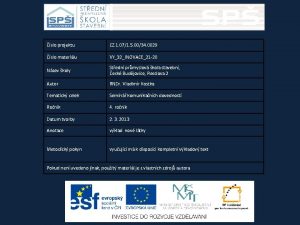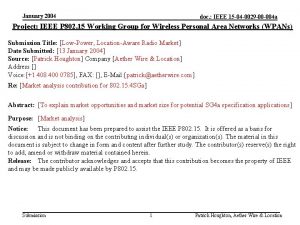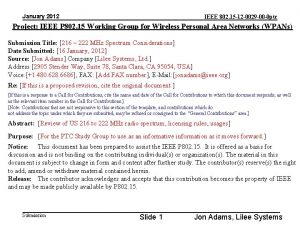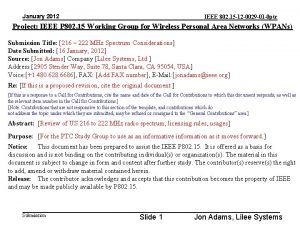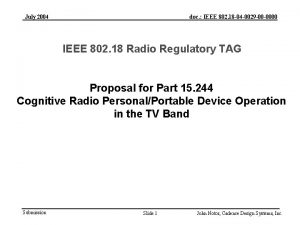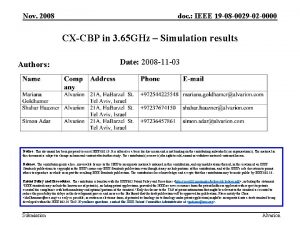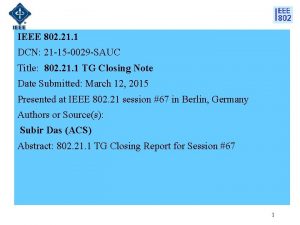January 2010 doc IEEE 802 15 10 0029









- Slides: 9

January 2010 doc. : IEEE 802. 15 -10 -0029 -00 -0006 Project: IEEE P 802. 15 Working Group for Wireless Personal Area Networks (WPANs) Submission Title: Opening Report for the TG 6 Session in January 2010 Date Submitted: January 16, 2009 Source: Arthur Astrin Contact: Arthur Astrin, Astrin Radio Voice: +1 (650) 704 -2517, e-mail: astrin@ieee. org Re: TG 6 Opening Report for January 2010 Session Abstract: Opening report for the TG 6 Session. Purpose: To focus activities during the meeting Notice: This document has been prepared to assist the IEEE P 802. 15. It is offered as a basis for discussion and is not binding on the contributing individual(s) or organization(s). The material in this document is subject to change in form and content after further study. The contributor(s) reserve(s) the right to add, amend or withdraw material contained herein. Release: The contributor acknowledges and accepts that this contribution becomes the property of IEEE and maybe made publicly available by P 802. 15. Submission Slide 1 Arthur Astrin

January 2010 doc. : IEEE 802. 15 -10 -0029 -00 -0006 IEEE 802. 15 TG 6 Body Area Network Opening Report 13 th Meeting as a Task Group 6 Los Angeles, CA January 18, 2009 Submission Slide 2 Arthur Astrin

January 2010 doc. : IEEE 802. 15 -10 -0029 -00 -0006 Merger Status 1 Samsung-ETRI-CUNY-KETI-KORPA-Inha-CNU-CSEM 2 NICT-YNU-Meiji-TI-Philips-GE-Toumaz-Fujitsu-CEA-FTThales-Tensorcom-Olympus-(LG)(Mitsubishi)(NIST) 3 IMEC OR GD 4 Zarlink Submission Slide 3 Arthur Astrin (Astrin Radio)

January 2010 doc. : IEEE 802. 15 -10 -0029 -00 -0006 Plans for January 2010 meeting • Received normative text of proposals in Word. doc format • Combine the normative texts and • remove redundancies. • resolve conflicts. • Begin editing into a baseline draft in March Submission Slide 4 Arthur Astrin

January 2010 doc. : IEEE 802. 15 -10 -0029 -00 -0006 Private Merge Discussions Numerous off-line merge discussions are carried among different parties for both PHY and MAC. Submission Slide 5 Arthur Astrin

January 2010 doc. : IEEE 802. 15 -10 -0029 -00 -0006 Timeline 2010 2009 Merge Proposals 2010 9 10 11 12 1 > > > 3 4 5 > > > 6 7 > > 8 9 > > 10 11 > > Technical Comments Resolution > > Draft Ready for 1 st letter ballot complete Resolution of comments, 1 st recirculation > 1 st re-circulation complete > Resolve comments, 2 nd recirculation, apprv > 2 nd re-circulation complete > Resolve comments, 3 rd recirculation apprv. > Submission 12 > Agree content for Baseline Draft Work 2 Slide 6 > Arthur Astrin (Astrin Radio)

January 2010 doc. : IEEE 802. 15 -10 -0029 -00 -0006 • Thank You ! • Any Questions ? Submission Slide 7 Arthur Astrin (Astrin Radio)

January 2010 doc. : IEEE 802. 15 -10 -0029 -00 -0006 Purpose of Proposed Standard (PAR 07 -0575) The purpose of the proposed standard it to provide an international standard for a short range (ie about human body range), low power and highly reliable wireless communication for use in close proximity to, or inside, a human body. Data rates, typically up to 10 Mbps, will be offered to satisfy an evolutionary set of entertainment and healthcare services. Current PANs do not meet the medical (proximity to human tissue) and relevant communication regulations for some application environments. They also do not support the combination of reliability (Qo. S), low power, data rate and noninterference required to broadly address the breadth of body area network applications. Submission Slide 8 Arthur Astrin

January 2010 doc. : IEEE 802. 15 -10 -0029 -00 -0006 Need for the Project (PAR 07 -0575) There is a need for a standard optimized for ultra low power devices and operation on, in or around the human body to serve a variety of applications including medical and personal entertainment. Examples of the applications served by the proposed standard are: EEG, ECG, EMG, vital signals monitoring (temperature (wearable thermometer), respiratory, wearable heart rate monitor, wearable pulse oximeter, wearable blood pressure monitor, oxygen, p. H value , wearable glucose sensor, implanted glucose sensor, cardiac arrhythmia), wireless capsule endoscope (gastrointestinal), wireless capsule for drug delivery, deep brain stimulator, cortical stimulator (visual neuro-stimulator, audio neuro stimulator, Parkinson’s disease, etc…), remote control of medical devices such as pacemaker, actuators, insulin pump, hearing aid (wearable and implanted), retina implants, disability assistance, such as muscle tension sensing and stimulation, wearable weighing scale, fall detection, aiding sport training. This will include body-centric solutions for future wearable computers. In a similar vein, the same technology can provide effective solutions for personal entertainment as well. The existence of a body area network standard will provide opportunities to expand these product features, better healthcare and well being for the users. It will therefore result in economic opportunity for technology component suppliers and equipment manufacturers. Submission Slide 9 Arthur Astrin
